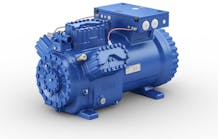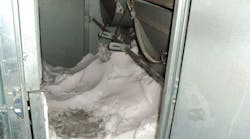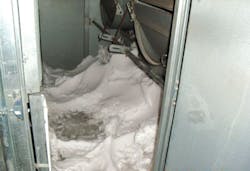In the March 2014 installment in HPAC Engineering’s “What Owners Need to Know About ...” series, Peter D’Antonio, PE, CEM, LEED AP, discusses HVAC preventive maintenance best performed by K-12 schools during summer (“What Owners Need to Know About ... School Summer HVAC Maintenance”). In this installment, we take a look at HVAC preventive maintenance performed by K-12 schools during fall and winter.
Heating-System Operation Is Your No. 1 Priority
During fall and winter, the top maintenance priority is to keep the heating system functioning. If the heating system fails or needs to be shut down for unplanned maintenance, school is likely to be cancelled. Additionally, the risk of building damage caused by pipes freezing and bursting significantly increases.
Heating-system maintenance should start with a written plan. Determine what should be checked on a daily, weekly, monthly, and yearly basis. Also, determine who is responsible for those activities.
Regular inspection of heating-system operation is necessary to verify the system is operating properly and to quickly identify broken or malfunctioning components.
Perform Lay-up and Maintenance of Cooling Equipment
During summer, some school buildings remain in operation, requiring the continued operation of the cooling system and prohibiting the performance of cooling-system maintenance. When a cooling system finally is shut down is the time to start annual maintenance. This should be part of the written maintenance plan, so tasks are identified and can be started immediately. If cooling-system maintenance is delayed until the end of winter or start of spring, the unexpected discovery of a major repair could delay system startup.
Some equipment requires specific lay-up procedures. Cooling towers may need to be drained, condensate drain traps on outdoor air-handling equipment may need to be emptied or removed, and chillers may need to be shut down a certain way. In any case, manufacturer guidelines should be followed. The improper shutdown and lay-up of equipment for the winter could result in significant damage to the equipment.
Beware of Snow and Ice
Winter HVAC maintenance may include removing snow and ice that accumulated around equipment during a school break or storm. Data-room condensing units can become buried in snow drifts—even if located on a roof—if shut down for an extended period. Snow also may accumulate in front of outdoor-air-intake louvers.
In the event of an ice storm, all outdoor equipment and outdoor-air intakes should be inspected for proper operation and the free movement of components. Ice can penetrate small openings and build up on components, hindering their operation.
Follow Through With Scheduled Maintenance
In his article, D’Antonio describes the need for a database of maintenance procedures and schedules for all equipment. Be sure this database includes fall and winter maintenance requirements, so schedules and staffing needs are known well in advance.
Following through on a written maintenance plan during winter will minimize premature equipment failure and reduce staff workload during summer, when completion of the multitude of summer maintenance tasks is the top priority.
Use Your Eyes, Ears, and Common Sense
Unusual sights and sounds in and around HVAC equipment may indicate an impending failure or blockage. Acting on these observations is important, as unexpected HVAC failures could be disruptive to occupants or damaging to the building and equipment. Further, needed repairs may not be able to wait until a summer shutdown period.
Address Occupant Complaints
In general, ANSI/ASHRAE Standard 55, Thermal Environmental Conditions for Human Occupancy, indicates that if 80 percent of the occupants of a space are comfortable, then the standard for comfort has been met. Even then, however, facilities personnel should listen to occupant comments and determine if a complaint is a personal preference or may be indicative of a system-operation issue.
In a new school building, following up on HVAC-system complaints is especially important during the first winter of operation. Investigations may uncover construction or startup issues that can be resolved while the building still is under warranty. For example, during the first winter of operation for a new 300,000-plus-sq-ft school building, instructors in a five-classroom area complained of cold temperatures. The HVAC system was operating properly in all other areas of the building. Investigations revealed unintended direct openings from the ceiling plenum to the exterior roof soffit, which allowed cold outdoor air to infiltrate the ceiling plenum and then the classrooms. The prompt investigation into the complaints resolved a condition that eventually could have resulted in building damage from frozen pipes.
Scheduling
Fall and winter HVAC maintenance requires increased communication and scheduling with building operations. Maintenance is easier to schedule during summer, when school buildings are mostly unoccupied. During winter, unoccupied periods are fewer and shorter.
Summary
Fall and winter HVAC maintenance has unique challenges. Proper planning, inspection, and response are critical to successful and cost-effective building operation.
Acknowledgements
The author would like to thank the following for their input related to this article: Tim Fultz, East Liverpool City Schools, East Liverpool, Ohio; Ed Leitch, Geneva Area City Schools, Geneva, Ohio; and David Huff, University School, Hunting Valley, Ohio.
James G. MacMillan, PE, LEED AP BD+C, is senior vice president and director of sustainability for Karpinski Engineering in Cleveland. He is one of the firm’s key principals for K-12 and higher-education projects, with which he has more than 25 years of experience. Over the last 15 years, he has been responsible for design and engineering project management of more than 50 K-12 projects. He presents on geothermal HVAC systems and sustainability at ASHRAE and The American Institute of Architects conferences.
Did you find this article useful? Send comments and suggestions to Executive Editor Scott Arnold at [email protected].










